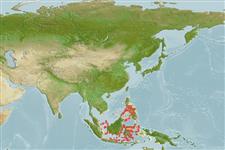>
Blenniiformes (Blennies) >
Blenniidae (Combtooth blennies) > Salariinae
Etymology: Istiblennius: Greek, istios = sail + Greek, blennios = mucus (Ref. 45335).
More on author: Herre.
Environment: milieu / climate zone / depth range / distribution range
Écologie
marin démersal; profondeur ? - 2 m (Ref. 83651). Tropical
Western Pacific: known only from Culion and Panay islands, Philippines.
Taille / Poids / Âge
Maturity: Lm ? range ? - ? cm
Max length : 11.8 cm SL mâle / non sexé; (Ref. 9962); 10.3 cm SL (female)
Description synthétique
Morphologie | Morphométrie
Épines dorsales (Total): 13 - 15; Rayons mous dorsaux (Total): 18-20; Épines anales 2; Rayons mous anaux: 19 - 21. Dorsal fin XIII to XV, 18 to 20 (usually XIV); membrane between spinous and segmented-ray portions notched deeper than half length of first segmented ray; membrane from posteriormost ray attaching to point ranging from between dorsal edge of caudal peduncle well in advance of caudal-fin base to dorsal edge of caudal fin just posterior to base (usually anterior to caudal-fin base); posteriormost anal-fin ray not bound by membrane to caudal peduncle; skin covering anal-fin spines and anterior segmented rays not modified in adult males; pectoral-fin rays 14 or 15 (15 only unilaterally, in only 2 of 46 specimens examined for character); dorsal procurrent caudal fin rays 6 to 8 (typically 7), ventral procurrent rays 6 to 8 (typically 7), total procurrent rays 12 to 15 (typically 14), segmented rays 13. Lacking nape cirrus. Orbital cirrus consisting of flattened central stalk with up to 7 branches on each lateral and medial margin; less than orbital diameter in females, ranging from less than to slightly greater than orbital diameter in males. Nasal cirrus short, ranging from ragged-edged flap to palmate flap with up to 16 irregular branches; lacking posterior canines; ventral margin of upper lip entire; dorsal margin of lower lip varying from entire to weakly, irregularly, and almost unnoticeably crenulate (irregularities almost entirely restricted to corners of lip). Males with well-developed, blade-like crest on head; females lack crest, but females generally at 6.8 to 8.6 cm SL with faint, ridge-like crest precursors; male crest uniformly dusky or covered with dusky spots or granular vermiculations; remainder of head either almost uniformly dusky or with fine, dusky spots on opercle. Male max. size 11.8 cm SL; female max. size, 10.3 cm SL.
Facultative air-breathing (Ref. 126274); Oviparous. Eggs are demersal and adhesive (Ref. 205), and are attached to the substrate via a filamentous, adhesive pad or pedestal (Ref. 94114). Larvae are planktonic, often found in shallow, coastal waters (Ref. 94114).
Life cycle and mating behavior
Maturité | Reproduction | Frai | Œufs | Fécondité | Larves
Oviparous, distinct pairing (Ref. 205).
Springer, V.G. and J.T. Williams, 1994. The Indo-West Pacific blenniid fish genus Istiblennius reappraised: a revision of Istiblennius, Blenniella, and Paralticus, new genus. Smithson. Contrib. Zool. 565:1-193. (Ref. 9962)
Statut dans la liste rouge de l'IUCN (Ref. 130435)
Menace pour l'homme
Harmless
Utilisations par l'homme
Plus d'informations
Taille/ÂgeCroissanceLongueur-poidsLongueur-longueurFréquences de longueursMorphométrieMorphologieLarvesDynamique des populations larvairesRecrutementAbondanceBRUVS
RéférencesAquacultureProfil d'aquacultureSouchesGénétiqueElectrophoresesHéritabilitéPathologiesTraitementNutrientsMass conversion
CollaborateursImagesStamps, Coins Misc.SonsCiguateraVitesseType de nageSurface branchialeOtolithesCerveauxVision
Outils
Articles particuliers
Télécharger en XML
Sources Internet
Estimates based on models
Preferred temperature (Ref.
123201): 28.4 - 29.2, mean 28.8 °C (based on 316 cells).
Phylogenetic diversity index (Ref.
82804): PD
50 = 0.5001 [Uniqueness, from 0.5 = low to 2.0 = high].
Bayesian length-weight: a=0.00741 (0.00335 - 0.01640), b=3.02 (2.83 - 3.21), in cm total length, based on LWR estimates for this (Sub)family-body shape (Ref.
93245).
Niveau trophique (Ref.
69278): 2.0 ±0.00 se; based on food items.
Résilience (Ref.
120179): Haut, temps minimum de doublement de population inférieur à 15 mois (Preliminary K or Fecundity.).
Fishing Vulnerability (Ref.
59153): Low vulnerability (10 of 100).
